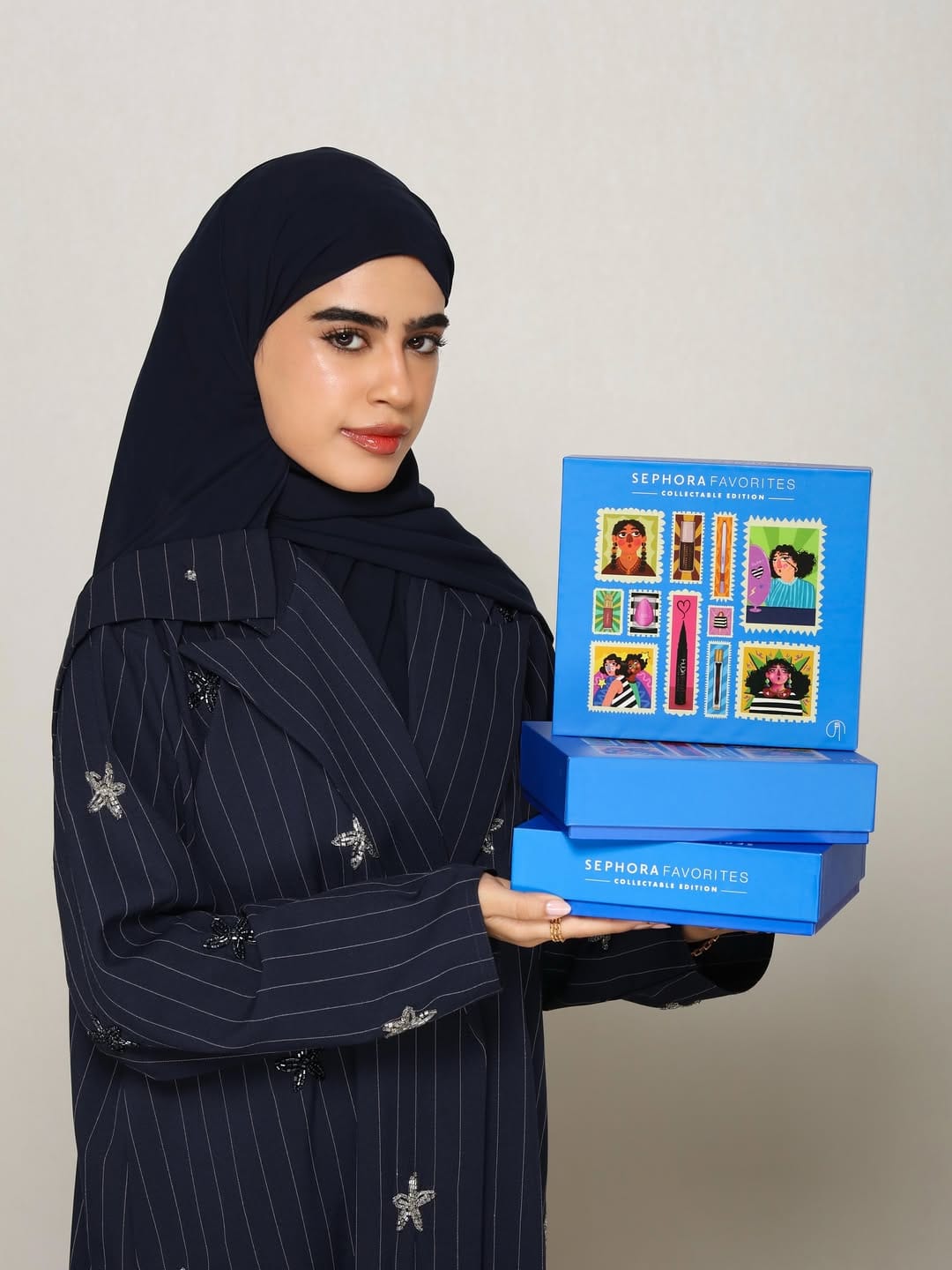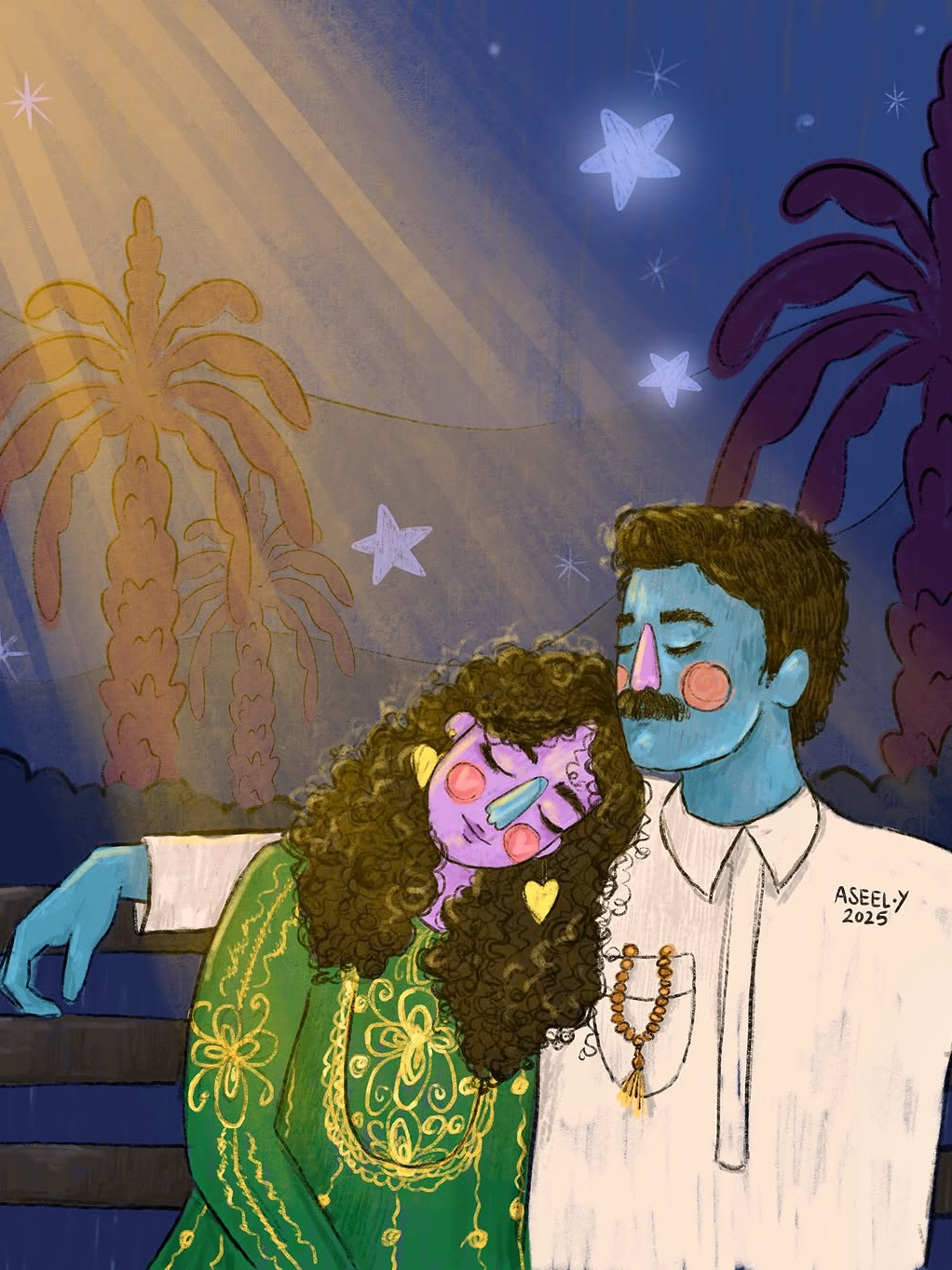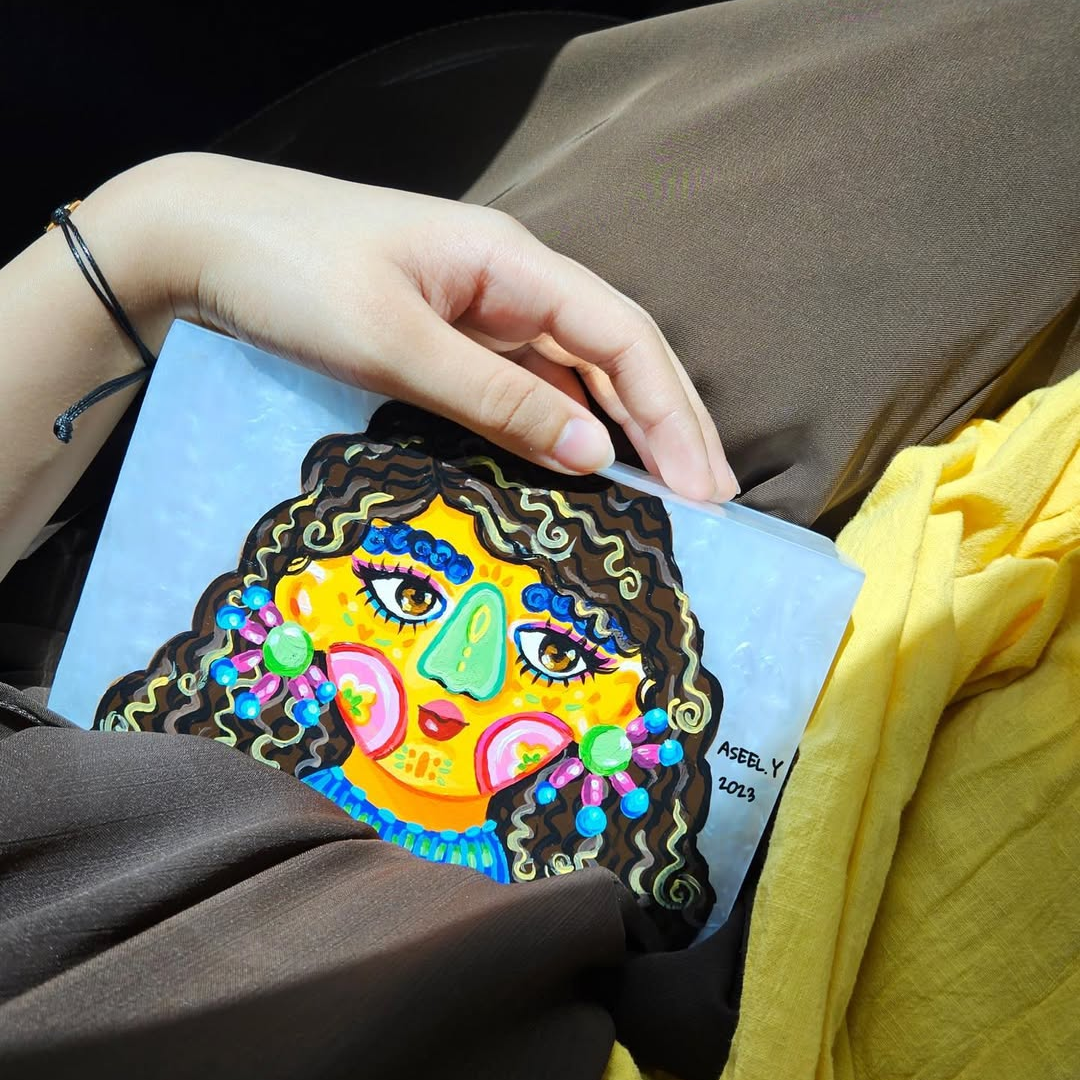
I want to show the world how much beauty exists in our heritage, through a contemporary, deeply human vision.
In a country moving at the speed of vision plans and giga projects, Aseel Al Yaagoub is quietly building a different kind of monument. Hers is not made of glass and steel, but of faces, gestures and small domestic moments, preserved in bright color.
Through painting, printmaking and digital design, the Saudi artist turns Gulf memory into something that feels immediate, playful and unmistakably contemporary. Her work looks like nostalgia redesigned for the Instagram generation, yet it carries the emotional weight of family albums and oral stories.


Early Influences and the First Sketches
Before Aseel’s work lived on gallery walls or brand campaigns, it lived where most strong visual languages begin: at home.
She has often described growing up in a family that loved art, where drawing was encouraged rather than treated as a distraction. That early permission to create is visible in the freedom of her lines today. There is nothing timid about her color choices. She does not chase realism in a classical sense. Instead, she leans into exaggeration, humor and emotion.

Growing Up Between Worlds
Like many Gulf artists of her generation, Aseel Al Yaagoub came of age at an interesting crossroads. Satellite TV, early social media and global pop culture were all pouring in. At the same time, the textures of local life remained strong. The patterned cushions in the living room, the smell of cardamom coffee, the ritual of getting dressed for visits and weddings. These details became her visual vocabulary.
What makes her distinct is how she chose to respond. Rather than turning away from tradition in search of something more “international,” she doubled down on the world she knew best. The result is an art practice that feels both deeply Saudi and globally readable.


Building a Visual Language of Faces
If you scroll through her Instagram or stand in front of her works, one thing appears again and again: the face.
Aseel’s portraits have a particular presence. Eyes are large and direct. Cheeks are circles of blush, sometimes pink, sometimes orange or red. Lips are often reduced to a single simple line. Yet within this simplicity there is a surprising amount of character.


The Nose as a Signature
Her most distinctive signature is the nose. She loves drawing noses, and she treats each one as a personality statement. Some are long and sharp, others softly curved, some shaded in unexpected colors like teal or plum. The nose becomes a way of insisting on individuality in societies that are sometimes stereotyped from the outside as uniform.
These faces are not portraits of specific celebrities or elites. They feel like neighbors, cousins, classmates or the woman you once saw across a wedding hall and never forgot. That is where her talent lies. She has a way of making the ordinary feel iconic without turning people into caricatures.
A Father’s Shemagh in the Frame
Aseel’s depictions of men also carry personal resonance. Many of her male figures have broad shoulders and hair that subtly echo her father’s features. In several paintings, she incorporates her father’s own shemagh, the traditional headscarf, as a way to infuse familial memory into cultural representation. These quiet nods bring a deeper emotional register to her work, turning what might seem like generic characters into vessels of lived experience.


Color as Atmosphere and Emotion
Color plays a crucial role. Backgrounds are often flat planes of pastel or bold tones. Clothing patterns are hinted at rather than fully rendered. The eye travels first to the face, then drifts outward to take in the story. You can almost hear the conversations these characters might be having.


Heritage in the Age of Screens
Aseel Al Yaagoub's stated goal is simple yet ambitious: to preserve Saudi culture through art. The way she approaches this is anything but nostalgic in the conventional sense.
Rather than painting historical scenes with perfect architectural accuracy, she focuses on the lived texture of heritage. Traditional motifs appear frequently in her work. Embroidered dresses. Abayas with distinctive cuts. Headscarves and ghutras, drawn with affectionate attention. Jewelry, especially pieces that many Saudis remember from their mothers and grandmothers. Henna, coffee cups, trays of sweets, birds and plants that carry quiet symbolic meaning.


Archiving Ways of Being
Yet the mood of her artwork is firmly present-day. Her characters do not look like they stepped out of a museum display. They look like people you might meet this week in Riyadh, Dammam or Al Ahsa, carrying with them visual echoes of older generations.
In a world where culture is often flattened into branding or trends, Aseel’s work acts as a reminder that heritage lives in ongoing practice, not just history books. It is there in how people dress, how they sit, how they relate to one another. By capturing these gestures, she is archiving more than costumes. She is archiving ways of being.

Between Canvas and Screen
Aseel’s practice moves between canvas, digital screen and collaborative projects with ease. In her studio work, she paints and prints characters that feel like they belong to one continuous universe. Families, friends, couples, children, pets. They reappear in different compositions, almost like recurring characters in a favorite series. Some works are intimate close-ups of two faces. Others show larger scenes where multiple figures share a single emotional atmosphere.
Alongside this, she embraces digital tools. Her illustrations translate beautifully to screens, which has helped her connect with a younger audience and made collaboration a natural extension of her practice.
Collaborations with Sephora and Bisat
In recent years, that has included headline projects with Sephora and Bisat Cafe. With Sephora, her drawings have appeared in campaigns that celebrate Saudi identity through beauty, turning packaging and digital assets into miniature canvases filled with Gulf color and character. With Bisat, she has designed pieces like storytelling drinkware and Eid morning scenes that bring together details from Najdi and Eastern culture in a single, cinematic frame.
Collaborations like these raise important questions for many artists: how do you protect the integrity of your cultural motifs when they enter a commercial context, and how do you make sure heritage is not used as a costume. Aseel’s answer is to stay close to her own characters and visual language. She brings brands into her world, rather than reshaping herself completely for theirs, so that every collaboration still feels unmistakably hers.



A Quiet Mentor for Emerging Artists
As her visibility has grown, especially through social media and televised interviews, Aseel has become a reference point for many young Saudi creatives. When she speaks to aspiring artists, her advice tends to be grounded and practical rather than grand or abstract. She talks about taking the work seriously even if you are juggling other responsibilities. About carving out daily or weekly time to draw, paint or design. About learning from feedback without losing your own voice.
There is something particularly resonant about seeing a Saudi woman artist who moves confidently between painting, illustration, home life and public projects. For younger women in particular, Aseel represents a model of creative life that is both ambitious and relatable. She is not distant or inaccessible. She feels like someone you could meet at a local exhibition and talk to about brushes and iPad apps in the same breath.


A Visual Language of Belonging
At the heart of Aseel Al Yaagoub's work is a quiet question of belonging. To family, city, Gulf and a rapidly changing Saudi moment. Saudis and Gulf viewers often recognize themselves in a dress detail, a glimpse of hair, a familiar living-room color, while international audiences enter through her bold faces and lush palettes. Her paintings act like soft diplomacy, inviting people into everyday scenes rather than explaining culture, and her characters remain absorbed in their own worlds, seen but never defined by our gaze.

Why Aseel’s Work Matters Now
Saudi Arabia’s contemporary art scene is expanding at high speed. Biennales, museums, art districts and international collaborations are rewriting the cultural map. Within this powerful infrastructure, artists like Aseel Al Yaagoub ensure that small stories are not lost. She reminds us that transformation is not only measured in skylines and headlines. It is also visible in the quiet continuity of family rituals, in the evolution of dress, in the faces of people who carry both past and future in their expressions.
Follow Aseel’s journey as it unfolds on Instagram and through her latest updates on LinkedIn.
Inspired by Aseel Al Yaagoub?
Explore more artist stories that shape Saudi culture at KSA Art.

